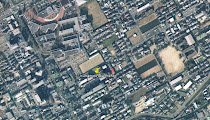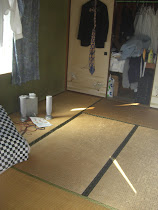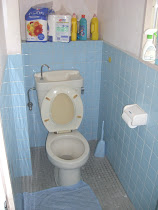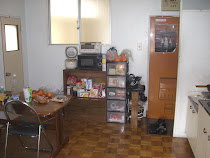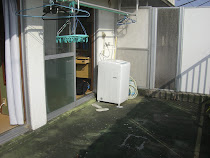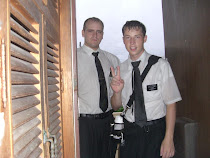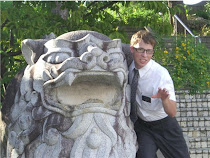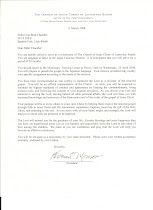
Elder Chandler has been transferred! He is now serving in Nobeoka-shi. It is on the east side of Kyushu.
 The outer part of the logo symbolizes the Japanese hiragana (rounded Japanese phonetic lettering) character "no" 「の」, and the inner part symbolises the hiragana character "be" 「べ」. The logo as a whole symbolizes the Chinese character "oka" 「岡」. Put together, these three parts represent "No - be - oka".
The outer part of the logo symbolizes the Japanese hiragana (rounded Japanese phonetic lettering) character "no" 「の」, and the inner part symbolises the hiragana character "be" 「べ」. The logo as a whole symbolizes the Chinese character "oka" 「岡」. Put together, these three parts represent "No - be - oka"."Japan's Best 100 Waterfalls" were chosen with the purpose of, through waterfalls, fostering an open mind to live symbiotically with nature, and protecting waterfalls which symbolize Japan's beautiful natural environment. Along with Mukabaki Falls, within Miyazaki Prefecture, Sekino Falls (Miyakonojo), Yatogi Falls (Tsuno Town), and Manai Falls (Takachiho), were chosen in the top 100.

Mount Mukabaki is formed by two ridges. The left peak is known as Odake (namely the "male peak", which is most commonly climbed and where the highest point of the mountain is), and Medake (the "female peak", which is not generally climbed). Mukabaki Waterfall flows down through these two peaks. The waterfall is approximately 77 metres high, and roughly 30 metres wide. The magnificent view of the waterfall, which can be seen from the mountain trail, is loved by many citizens and mountain climbers.


The Nobeoka Festival is held over 2 days at the end of July, and is a festival that celebrates Nobeoka City. It begins with an "encounter of portable shrines", where over 1, 000 people involved in carrying these shrines (mikoshi), compete to see which is the bravest mikoshi team. The festival welcomes in a climatic end, with the "combined Bamba Dance" (a variety of Lantern Festival dance), in which over 5, 000 citizens participate. And, close to 10, 000 fireworks also brightly decorate the night sky during the fireworks festival.


Climate
The climate of Nobeoka is hot and humid in the summer (above 30 °C) and is somewhat cold in the winter with temperatures dropping to around freezing (0 °C). Snowfall can be seen in the winter months, but does not accumulate because of coastal warming effects.
Economy
The city's economy depends strongly on the company Asahi Kasei, a producer of synthetic and industrial fibers.

It is known regionally for its Ayu fish.
Transportation
Nobeoka is the terminal station for trains that run the length of the prefecture (although some trains do continue up into Oita prefecture). It used to be the terminal station for the privately owned takachiho line, which ran towards Kumamoto prefecture from the northeast to the northwest of the prefecture. This line was closed after a typhoon in 2005, and has not been reopened.

Chicken NambanNobeoka is the birthplace of "Chicken Namban" , a taste representative of tropical Miyazaki. Within NobeokaCity, there are two types of Chicken Namban: a simple dish with a sauce comprising of vinegar, sweetened with sugar and mirin (sweet alcohol used for seasoning); and a Western style dish with the added flavour of tartar sauce.

Sky Flying New Spring Onions (Sora Tobu Shin-Tamanegi)Sky Flying New Spring Onions are a brand of onion created to be the earliest onions to come on the market during the season in Japan. Their sweetness and crisp texture is perfect for salads. They are also used in manufactured foods such as konnyaku (a gelatinous food made from devil's-tongue starch), soup and dressings.

Torn Steamed (Sweet Bean) Buns (Yabure Manjyu)It is said that Torn Steamed (Sweet Bean) Buns were made in the area near NobeokaCastle from as early as the Year 19 of the Keicho Era (1614). Their original name was " Agatama Manjyu" , but they gradually came to be called “Yabure Manjyu”, due to the torn pieces of their outer surface which allowed the sweet red bean inside to be seen. (“Yabure” means “torn” and “manjyu” is a “steamed bun with sweet bean inside”).

NobeokaCity in ancient times, during the period where different feudal clans ruled separate areas, was a city that flourished as a castle town under the Naito Family. (The Naito Family boasted an economic power expressed in a yearly harvest of 70, 000 koku {equal to 358, 400 bushels or 2, 867, 200 gallons} of rice).
In modern times, NobeokaCity takes pride in being Eastern Kyushu’s number one industrial city. With a population of over 130,000, it has become a central city in the northern region of MiyazakiPrefecture, and its development has continued through until this day.
“Nobeoka Tengaichi Takigi Noh Theatre” (a world class traditional Japanese play put on outdoors with light supplied by bonfires), today tells of such history and culture. The Takigi Noh Theatre is held each year at the beginning of October, and uses Noh masks which were handed down from Nobeoka’s previous feudal lords, the Naito Family. These masks were made by craftsman who have received the title of “the best in the world” at their trade.
This Noh dance takes place at the Nobeoka Castle Ruins of Shiroyama Park, in the space of the second outer castle enclosure. It is set upon a backdrop of the stone wall commonly known as “The Killer of a Thousand People”, and invites viewers into a world of mysterious profundity.
In addition, Nobeoka City, which has been selected as being one of the “100 Most Beautiful Water Villages in Japan”, has come to be known by people under the title of “Water Village Nobeoka”, due to the clear full streams of Gokase River, Ose River and Houri River, which run through the city.
NobeokaCity: An industrial city, and a city that abounds in nature, history and culture.
Please come and visit us in Nobeoka, the city with a great variety of characteristics peeping out from within.

 Tokyo Time
Tokyo Time
